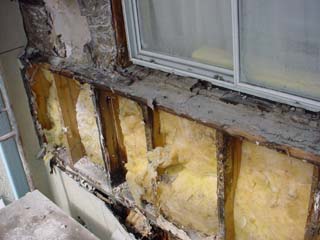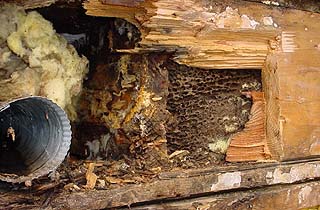|
Subscribe / Renew |
|
|
Contact Us |
|
| ► Subscribe to our Free Weekly Newsletter | |
| home | Welcome, sign in or click here to subscribe. | login |
Construction
| |
 |
October 9, 2003
Time to get serious about moisture
Remco Services

Photo courtesy of Remco Services
Shoddy construction can invite moisture-related damage, including mold and wood rot. The building here suffers from poor waterproofing details, inadequate flashing and improper installation of the windows, building paper and stucco system. |
As a repair and restoration general contractor, I have seen firsthand how the Northwest climate can affect our buildings. Most of my experience has been repairing buildings that have suffered damage due to water and moisture intrusion.
Our firm has evolved within an emerging segment of the Northwest construction industry that specializes in solving and repairing water intrusion issues and construction defects.
Why exteriors fail
Over the years, much of my time has been spent working with forensic architects and engineers to determine why the exterior systems of a building fail to keep water and moisture away from the internal structure.
Through this research, construction methods have been developed that will help us avoid the same problems in the future. Unfortunately, these methods have not become industry standard and thus are not familiar to everyone who builds here.
As a general rule, the methods used to weatherproof a building are fairly simple to understand and implement. Nevertheless, the number of buildings suffering water damage has not diminished. Why is this so?
For those involved in this industry, it is an ongoing debate. Some believe that we, as builders, have forgotten how to build in a weather-wise fashion or that it is cost- and time-prohibitive to involve weatherproofing specialists during design and construction.
Some will claim that advances in technology have outpaced the expertise of the average craftsmen. Others will argue their methods are sound in spite of evidence to the contrary.
Every water-damaged project has its own story to tell and its own unique reason for reaching the point of disrepair. Unfortunately, this makes it difficult to pinpoint a single cause for the problem of building envelope failures.
Whatever the issue may be, there is one thing I am certain of: as contractors, we can do a few simple things to increase the chance that the buildings we construct will survive the Northwest climate.
Understand the climate
A knowledge and understanding of the potential hazards of water intrusion may be enough to avoid many of the pitfalls. It is important as a builder, designer, or property owner to understand how the Northwest climate affects the structures we build.
There are many components to the construction process and it can be difficult to keep up with evolving techniques. Be conscious of limitations in your experience and be open to continuous education.
Understand the materials

Photo courtesy of Remco Services
Burrowing ants left behind the honeycombed wood shown here. Moisture seeped in after the exterior cladding system was installed improperly. |
Take the time to learn how the climate affects our buildings and the materials we use to build them. Our natural resources are diminishing and alternative products are a necessary part of the sustainability of our industry.
Do your research. Understand how temperature and moisture can affect the performance and installation requirements of the materials you use. Talk to the manufacturers, especially their technical representatives.
At a minimum, read the manufacturer’s recommendations and installation instructions. Be sure you know what you are working with and its intended purpose.
Attention to details
This does not have to be an expensive endeavor. The water intrusion problem may simply boil down to the expertise of your workforce.
Hire people who understand the importance of superior work. Involve local experts in educating your employees about the dangers of water and moisture intrusion; teach them the importance of sound waterproofing.
Enroll your employees in training programs to build their knowledge base in successful and evolving techniques. Additionally, use mock-ups as tangible aids to demonstrate the work quality you expect.
Be sure the weatherproofing details are provided to you in the construction documents. Do not proceed with a project if the owner has not commissioned a designer to think through the details. Review the documents carefully to ensure you have what you need to construct a weatherproof building.
Effecting change
The most difficult challenge is implementing the changes in your operation. Our employees will have to be taught the importance of proper weatherproofing techniques. Adding this duty to their already long list of responsibilities may be hard to do. You may have to add a quality-control program or alter your existing one to add a weatherproofing component.
A successful project takes the eyes of everyone involved. Empower your people to stop work if they don’t understand what they are doing or fear someone else may not be following the details. Halting production now is much cheaper than someone else finding your mistakes later.
It is clear that, as contractors, we shoulder the burden of the water intrusion risk. Our continuing success depends on our ability to adapt to the new challenges and implement change in an already demanding industry. We cannot meet this challenge alone.
The development and design communities need to accept their share of the responsibility.
Architects and engineers need to provide the construction team with enough information to have a chance at success. Developers and building owners need to adapt their budgets to allow the designers and contractors to include a good weatherproofing plan in the construction process.
The techniques for good weatherproofing may be simple, but convincing ourselves and our industry that they are important seems to be more difficult.
The effects of water intrusion can be immense and the cost of repair extraordinary. For a project to have a chance at surviving our difficult Northwest climate, it is paramount that the owner, architect and contractor all do their part.
Scott J. Olson is president and cofounder of Remco Services, a repair and restoration general contractor in the Puget Sound area.
Other Stories:
- Construction drying keeps moisture at bay
- Precautions during construction will save headaches later
- Consider your options for exterior cladding


